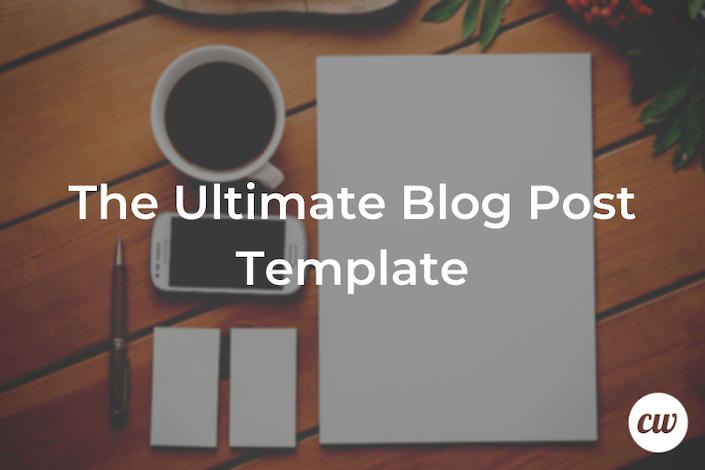
The Ultimate Blog Post Template
More than 4 million blog posts are shared online every single day, according to data from 2020. So, it’s only natural to want to get the right kind of attention with anything you might be planning to add to the blogosphere.
To give you a better idea of how to present what you want to share with your target audience, here’s a blog post guide to use for inspiration. Let’s break this down based on the most common blog styles or templates.
The List Blog Post Template
Often referred to as listicles, list posts are popular because they are easy to digest and highly shareable. Typically, a list blog post contains about 10 to 25 brief, interesting items aimed at the interests of your target audience.
The basic elements of a well-crafted list blog post include:
- A clearly stated benefit: The main benefit of a list blog post is typically stated right in the title of the list – e.g., 10 Great Ways to Boost Blog Subscribers
- Number of items: Give a definite number of items for your list blog post. Also, numbers in titles usually grab attention quickly.
- An ability to act quickly: If your list blog post is supposed to help readers achieve specific goals, make the items things readers can do fairly quickly. If you’re too vague or complex with what you suggest, your list will soon be forgotten.
A list blog post should also include an introduction and conclusion – even if the list is fairly self-explanatory).
The intro gives you a chance to briefly explain your list and provide any supporting details like your criteria for the list. The conclusion allows you to ask for comments, feedback, or suggestions for a possible related list to encourage engagement.
The Case Study Blog Post Template
A case study blog post is essentially a how-to post, except it’s backed by real-world examples. So, if you were going to do a post of this nature on how to lose pregnancy weight after giving birth, for example, you might do this by writing about a friend or family member who has successfully done this.
A case study blog post typically includes the following elements:
- A short, informative (and attention-getting) title
- A brief intro of what you’re going to present
- 1-2 paragraphs to introduce the focus of your case study – e.g., the person you are using as your real-life example
- A summary of the results that person saw, how they did it, and the steps involved
- A conclusion where you sum things up and include a motivational line or two along with a compelling call-to-action
A case study title doesn’t necessarily need to have a number, but this can be a great attention-grabber – e.g., How One Man Lost 30 Pounds in 6 Months.
Don’t shy away from case studies where the results reported by the subject are moderate or mixed with ups and downs before ending on a positive note. Case studies with amazingly impressive results tend to come off as unrealistic or not believable or achievable.
The call-to-action with a case study blog post doesn’t have to be revenue-based. A CTA that encourages sharing the post is going to serve you better for the purpose of boosting engagement and reach in this case.
The Product Comparison Blog Post Template
Blog posts presented this way offers a direct comparison of two or more products. The products can be something you offer for your business or products related to what you do or offer.
Regardless of what’s motivating you to do a product comparison blog post, the goal here is to offer an honest, beneficial opinion. After all, the intended reader of these posts will likely be checking out this type of content so they can make a well-informed purchase decision.
A product comparison blog post is more likely to be effective if it includes the following structure/elements:
- A title that makes it clear what products are being compared
- A brief intro of what’s being compared and encouragement to go through the entire review before making a decision
- An overview of the products being compared that includes a rundown of features, benefits, pros, cons, and anything else useful and relevant
- A conclusion where you sum up the results and give recommendations
It can be helpful to start with the more beneficial/positive features first when doing your product comparison posts. Doing so will give the reader the option of considering whether or not a product you may not have personally preferred might still be right for them.
The Beginner’s Guide Blog Post Template
If you have some knowledge related to your business or products you want to pass along, a beginner’s guide blog post is a great way to accomplish this task. It’s essentially a step-by-step guide designed to put the reader on the right track.
The great thing about a beginner’s guide post is it can be pretty much anything that fits into your industry or niche. That being said, it can help if you check social media comments and sort through your feedback first. This will give you a better idea of what your audience needs some help with.
Also, if you have an online chat feature, see what kind of questions your customers are asking. Again, this can give you a better idea of where to focus your beginner’s guide blog content.
When done right and presented correctly, a beginner’s guide can be a creative way to earn beneficial backlinks and snag some all-important shares and mentions on social media.
A beginner’s guide blog article will be more likely to resonate with the target audience if it includes:
- An intro that clearly states (1) what you’ll be explaining, (2) a general description of how you’ll be explaining it, and (3) an acknowledgment of how complex or challenging the task can be
- A general overview of the topic that includes any relevant definitions and explanations before you get into the steps involved
- A description of the steps in a logical, easy to follow order
- A recap of what you covered and a reassurance that the reader can benefit from the guide you just presented
A call-to-action can also be included in the conclusion to encourage comments and feedback. Links to any other related previous posts can be sprinkled throughout the post as well to gives readers a chance to further explore the topic or related ones.

The Personal Journey Blog Post Template
With this type of blog post, you’ll be either telling your own story or sharing another person’s inspirational journey. What you’re doing is forming an emotional connection with the reader. The story told should still relate somehow to the overall theme or purpose of your blog.
The setup with posts of this nature is fairly simple. After you come up with a compelling title, basic elements for these posts include:
- A brief intro that sets up the personal story you’ll be sharing
- A few paragraphs introducing the subject if it’s not you
- A breakdown of the personal journey that highlights any unique struggles, obstacles, or goals
- A concluding paragraph that sums up the journey and any lessons learned or related advice
- A CTA encouraging comments and feedback
You would think a personal journey post works better for an individual blog rather than a business one. However, this isn’t always the case. For instance, somebody just starting a new company or business could present personal stories related to their process or the problems their products/services are solving.
The How They Did It Blog Post Template
This one is kind of related to the personal journey blog post. The main difference is that the “they” can be an individual or other businesses in the same industry or niche. You can go even broader with the subject of posts like this, depending on the topic you want to cover.
Regardless of your preferred subject for this type of post, the goal here is to reveal the secret of their success and the impressive results that were achieved. You’ll also need to show the reader how they could achieve similar results.
For instance, if you present a post focusing on 10 Amazing Start-Ups That Defied the Odds with Effective Content Marketing, you’ll go over each featured start-up and how they wowed their target audiences with awesome content marketing.
The template for how they did it post one can be broken down into the following sections:
- A title that sets up who the “they” is – and includes a specific number if you’ll be listing several examples
- An intro where you clearly point out what each featured success story has in common
- A section where you go over the secrets and strategies that worked for each featured individual, business, or brand
- A conclusion where you sum things up and remind the reader that they can use similar tactics or strategies to achieve similar results
- An encouragement for readers to take action if they’re inspired by what was presented
- A call-to-action where you ask for comments/feedback
The Myth Buster Blog Post Template
How about stirring up a little controversy to generate interest in your blog posts? An effective way to use this tactic is to debunk certain myths associated with your business, industry, niche, or anything you offer.
With these posts, you’ll be making your case that the listed myths aren’t set in stone – or that they simply don’t hold water. But don’t worry about trying too hard to prove your assertions are correct. In fact, it’s often better if you leave some room for disagreement so you can spark conversation and encourage engagement.
Present a thorough and effective myth-buster blog post by including:
- A compelling title that explains what myths you’ll be busting
- An attention-grabbing intro and a basic explanation of what myths you’ll be debunking
- A rundown of each myth and the compelling data that, in your opinion, debunks each one
- A conclusion where you remind the reader of how you debunked the listed myths and a call-to-action that encourages feedback
The Nostalgia Blog Post Template
The purpose of a nostalgia post is to tap into the reader’s love of something awesome from the past to discuss something relevant or similar from the present. Such posts tend to generate interest and inspire sharing by tapping into curiosity about past trends, fads, or technologies.
So, let’s say, for instance, you sell smartphones. In this case, a nostalgia post might present a brief history of the telephone. And a clothing seller might focus on fashion trends from past decades as a tie-in to what’s offered now – and so on.
Set up this type of post with the following features:
- A compelling title that plays up the ere, item, or trend you’ll be referring to
- An intro that forms a connection between your nostalgic element and your business of what you’re offering now
- The main body where you play up the connection and take the reader on a trip back in time
- A conclusion where you go back to the tie-in you mentioned in the intro and sum things up
- An appropriate call-to-action that either encourages comments or a visit to your website
Final Thoughts
The specific template that suits your needs will depend on what your audience prefers. Even if you do find a style that gets more attention and results, don’t make things too predictable with your posts.
Any type of awesome content, whether it’s in blog posts, website content, or social media posts, will resonate better with online searchers and even loyal blog followers/subscribers if it’s not always presented the same way.
A good rule of thumb to follow is to think about what would appeal to you most when creating and presenting your blog posts. This will remind you to mix things up as you pick and choose which blog post template to use as your guide.
банки каталогKen is a freelance writer currently living in the Pittsburgh area of Pennsylvania. Born in California, his fondness for writing dates back to elementary school writing contests and led to positions on both high school and college newspapers. He earned a degree in Journalism and Communications from Point Park University and did work in data entry after college before transitioning to a full-time career as a freelance writer. While his areas of expertise are marketing and health-related content, Ken is a versatile writer and enjoys exploring and researching a variety of topics. When not busy knocking out articles, he likes to spend time with friends, go for walks, and discover new and exciting things about the world around him.




